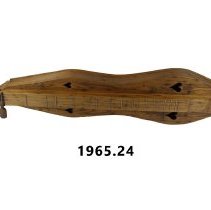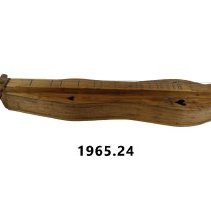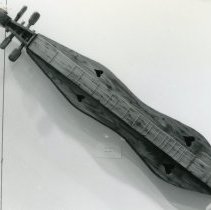Object Record
Images






Additional Images [5]





Metadata
Catalog Number |
1965.024 |
Object Name |
Dulcimer |
Description |
This bass dulcimer was crafted by Philip L. Hamer of Kingsport, Tennessee. The dulcimer is comprised of ash wood with steel strings. There is a green and white rectangular sticker inside of the dulcimer. Text is stamped on the sticker that reads: "Philip L. Hamer / 1216 Morningside / Kingsport Tenn #11." Additionally, "#11" is written on the interior of the dulcimer just below the sticker, likely indicating that this is the 11th dulcimer crafted by Philip Hamer. The following biographical excerpt was submitted by a Reece Museum volunteer in December 2024: "Philip LeClair Hamer was born in Oswego County, New York in 1905. After graduating from college with a B.S. in Forestry and Master's in Chemistry, he accepted a job with Mead Corporation in Chillicothe, Ohio where he met his future wife, Eva Frances Downing. He was transferred to Mead Corporation in Kingsport, Tennessee in 1942. During World War II he worked for Holston Ordnance Works (Eastman was a contractor for Holston, a manufacturer of ammunition and explosives). After the war he transferred to Eastman as a chemist. While in Ohio, Hamer visited a museum with a friend who was the director of a local historical society. He saw several different musical instruments and was intrigued by the dulcimer. Hamer's friend remarked, "I'd give anything if I had one of those." Back at home Hamer promptly began building a dulcimer like the one he'd seen. Philip undoubtedly mastered the craft by the early 1960s. It was around that period when an article he'd written about dulcimer making was published in Popular Mechanics magazine. Hamer typically built dulcimers on special order, and he enjoyed experimenting with different woods. The dulcimer in the Reece Museum's collection is the only large-scale dulcimer Hamer built. Hamer's dulcimers followed the traditional hourglass design, usually with heart-shaped sound holes, also traditional, and they were signed inside. By 1963 he had made about a dozen dulcimers. It is estimated he made around 50 custom dulcimers for people across the country. Hamer crafted his wife a special dulcimer with dogwood blossoms carved into the top. Hamer crafted two youth-sized dulcimers and two rebecs, a bowed, string instrument popular in the Middle East and Europe from the 13th to the 16th centuries, as well. When Hamer taught others to build dulcimers it was primarily through ready-to-assemble kits prepared for workshop participants in advance. He would also sell kits to individuals with complete and detailed instructions. In An Experiment in Woodcarving, a typewritten paper he authored before the advent of word processors, his attention to detail was evident, as was his enthusiasm for the topic and his good-humored personality. In the opening sentence of that paper he questioned the reader, "Isn't that a nice high sounding title? Of course this is what we are actually into, an experiment in woodcarving. Between you and me, however, you might consider it as just a lesson in whittling." Mrs. Hamer was a potter and substitute art teacher in the 1950s and also taught ceramics classes for adults at Dobyns-Bennett High School in Kingsport. Philip taught woodworking and dulcimer making in several workshop venues in the Southeast, mainly after he retired from Eastman in 1970 at age 65. In the summer of 1970, the couple spent six weeks in Monterey, Virginia and again in the late fall, conducting craft workshops during which he taught dulcimer making and she taught ceramics. Both were dulcimer players and performed at various locations, including Exchange Place in Kingsport. Maxine Cates, in a Kingsport Times article in 1963, described Hamer as a bespectacled and tranquil man. She quoted Hamer: "It's [the dulcimer] not very good as a solo instrument because it has its best place as an accompaniment to singing." Cates asked if he played his creations. He humbly replied, "I play a little in my spare time." Hamer said his real accomplishment was the satisfaction of working with wood, creating something that is usable and incites joy. Philip Hamer is described by his son Michael as "a curious fellow with many interests and passions." Hamer wrote short folk tales, enjoyed all genres of music especially if "it made you tap your foot," Philip said in the 1963 article. He studied languages including Spanish, German, and Russian at Dobyns-Bennett High School adult evening classes. Hamer wrote a book based on his journal entries, recollections and reflections on life. He taught himself Hebrew which helped enrich his deep interest in the Old Testament. Hamer was also a talented photographer, painter, and potter. He played the recorder and demonstrated this ancient woodwind instrument for others. The Hamer Family were members of the Southern Highlands Handicraft Guild (now known as the Southern Highlands Craft Guild) and the Kingsport Art Guild. They were members of Waverly Road Presbyterian Church in Kingsport where he served as deacon and elder. Philip Hamer died on April 9, 1992 at age 87." Image 11 shows an image of Philip Hamer holding this dulcimer, this only large-scale dulcimer that he crafted, as part of an article printed in the Kingsport Times in 1963. Image Courtesy of the Kingsport Times. |
Date |
c. 1960s |
Artist |
Philip L. Hamer |
Place of Origin |
USA/Tennessee/Kingsport |
Material |
ash, steel |
Subjects |
music American Art |
Search Terms |
Appalachian Art Musical Instrument Handmade |
